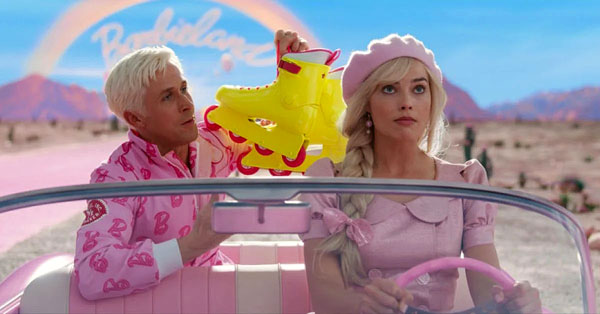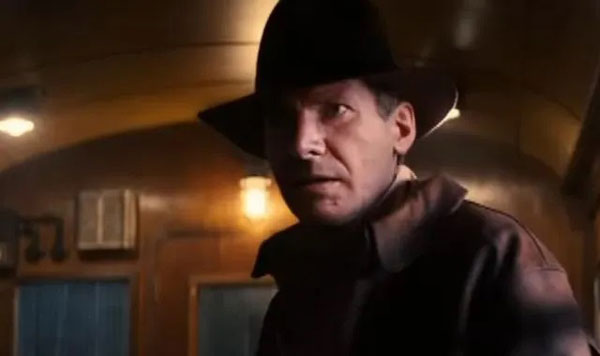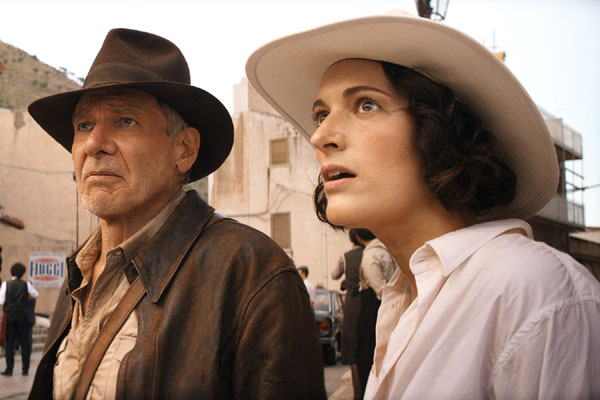|
Two
of the most iconic
fictional characters of
the late 20th century were
the subjects of summer
blockbusters. Greta
Gerwig's Barbie, the
smash hit of the year, is
a delightfully subversive
comedy that charts a
feminist odyssey for the
beloved fashion doll.
James Mangold's Indiana Jones and the Dial of Destiny, which
received an unexpectedly
(and in my opinion
unfairly) lukewarm
response, finds the
swashbuckling
anthropologist at loose
ends until a new adventure
helps him get his mojo
back.
Co-written by Gerwig and Noah Baumbach, Barbie begins
with a mock-2001 prologue—narrated
by a gleefully portentous
Helen Mirren—in
which little girls are
trapped in the Stone Age
of dolls designed strictly
to prepare them for
motherhood. It
ends—you guessed
it—with a girl
smashing her old dolls
with a Barbie. The
film then moves to the
main action, set in sunlit
Barbieland.
"Stereotypical" Barbie
(Margot Robbie) enjoys an
untroubled life in her hot
pink house, with her hot
pink wardrobe and hot pink
Corvette, surrounded by
all the other
Barbies. She isn't a
President Barbie, a Doctor
Barbie, or an Astronaut
Barbie, but she enjoys the
prestige of being the
original Barbie. At
night the Barbies party on
the beach with all the
Kens, who have nothing to
do except be accessories
to the Barbies.
Stereotypical Barbie's Ken
(Ryan Gosling) proudly
states his profession as
"Beach." He asks
Barbie if he can come back
to her house after the
party. "What for?"
she asks. "I don't
know," he answers.
But signs of trouble
appear in
Barbieland. Barbie
starts having thoughts of
mortality; even worse, she
starts developing
cellulite, and her
high-heel-ready feet turn
flat. Desperately
she turns for help to
Weird Barbie (Kate
McKinnon), a Barbie
disfigured from being
played with too
much. Weird Barbie
tells her she is having
the problems of her owner
in the Real World, and she
must go to her to resolve
them.

Barbie undertakes the journey to the Real World (Venice Beach, Calif.)
with Ken—who feels his life has no purpose without Barbie—as a
stowaway. The Real World holds a lot of shocks for Barbie. Sasha
(Ariana Greenblatt), Barbie's owner, despises her as a "fascist" who
makes women hate themselves—though Gloria (America Ferrera),
Sasha's mother, is considerably friendlier. Gloria works for Mattel,
Barbie's manufacturer, whose CEO (Will Ferrell) thinks the solution is
to put Barbie "back in the box." Ken, meanwhile, discovers a book on
patriarchy and returns alone with it to Barbieland. His further actions,
and those of the other Kens, are textbook examples of Alexander
Pope's dictum, "A little learning is a dangerous thing."
With Barbie, Gerwig builds on the achievement of her earlier films, Lady Bird and Little Women, artistically and thematically. Visually it
is both hilarious and resplendent, with cinematographer Rodrigo
Prieto, costume designer Ann Roth and production designer Sarah
Greenwood enveloping us in Barbie's candy-colored world. Even
better, however, is how Gerwig uses her encyclopedic knowledge of
Barbie folklore and fashion to make sprightly but pointed observations
about gender roles and how women are hampered by them. Barbie,
with her Candide-like innocence and optimism, has a little girl's view
of empowerment, and her encounters in the Real World make her
sadder but much, much wiser. Just as Pinocchio sought to become a
real boy, Barbie seeks to become a real woman. The film's unexpected
last line leaves us in no doubt that she has done so.
Robbie is delightful as Barbie, and Gosling fully matches her as Ken.
Ken's idea of masculinity is that of an early adolescent, as his big
ballad, "I'm Just Ken," demonstrates. Unfortunately, the Real World's
idea of manhood is as blinkered as Ken's, and it takes Barbie's newly
won wisdom to restore happiness to Barbieland.
Like Robbie and Gosling, the supporting players enter fully into Barbie's joyous spirit. Besides the aforementioned actors, I especially
enjoyed Michael Cera as Allan, the eternal, hapless extra man, and
Rhea Perlman as Ruth Handler, Barbie's sagacious creator.
Whereas Barbie taps into something eternally youthful, Indiana Jones
and the Dial of Destiny is a story of rejuvenation in old age. The first
Indiana Jones feature not directed by Spielberg or co-written by
George Lucas, Dial of Destiny begins with a prologue in which Indy
(Harrison Ford) and his timid sidekick Basil Shaw (Toby Jones) risk
their lives during World War II to rescue half of Archimedes' Dial—an
ancient time travel device built by Archimedes himself—from the
clutches of Nazi astrophysicist Jurgen Voller (Mads Mikkelsen).

The plot fast-forwards 25 years to 1969 Brooklyn, where Indy is living,
alone and despondent, in a junky apartment. It is his last day as an
archeology professor at Hunter College. He goes through the motions
of teaching his last class; attends a joyless retirement party, at which
he is given a clock; and, leaving the party, gives away the clock to the
first panhandler he sees.
At this low point in his life, Helena Shaw (Phoebe Waller-Bridge),
Basil's daughter, enters it. Helena's late father, she tells Indy, became
obsessed with finding the second half of Archimedes' Dial. She
suggests that she and Indy search for the second half together to
reunite it with the first half, which Indy has stored away in the college.
However, there are three things Indy doesn't realize at this point:
1. Helena has ulterior motives for wanting Indy's half of the dial.
2. Jurgen Voller is now working for NASA under the name "Dr.
Schmidt."
3. Voller's henchmen have killed two of Indy's colleagues at
Hunter, conveniently framing him for the murder.
You could say this would stir anyone out of a late-life funk. In any
case, Indy heads off on a new adventure to clear his name and retrieve
the dial. The action begins with him and his antagonists disrupting the
parade celebrating the Apollo 11 astronauts and an accompanying anti
-Vietnam War march. It continues across the Atlantic first to Tangier
and then to Greece, where the action includes a car chase, exploring a
shipwreck, and a properly peril-filled expedition to excavate
Archimedes' tomb. It ends with a spectacular plot twist—the content of
which, if you remember the purpose of Archimedes' Dial, you can
probably guess—and a quiet, touching coda.

The reviews of Dial of Destiny have been more favorable than not, but
some have been belittling. The nay-sayers accuse the filmmakers of
sourness and ineptitude, which I think is simply wrong. James
Mangold may lack Spielberg's trademark panache, but he is still a
skilled director, more than capable of filming thrilling action scenes,
which he does here. Furthermore, the screenplay by Mangold, Jez
Butterworth, John-Henry Butterworth, and David Koepp gives Indy a
persuasive future story and a moving final bow. Some viewers just
don't want to see a sad, bitter Indiana Jones, any more than they
wanted to see a sad, bitter Luke Skywalker in Star Wars: The Last
Jedi. But both films give their protagonists cogent reasons for their
sorrow, and both offer them redemption in ways that I, at least, found
satisfying.
Dial of Destiny also offers the return of beloved co-stars Karen Allen
and John Rhys-Davies (I will refrain from revealing their precise
significance in the current story) as well as newcomers such as Antonio
Banderas. Dial of Destiny is an honorable and endearing farewell to
Indiana Jones as he lays down his fedora and bullwhip for the last
time.
|